Search results for: 'den'
-
 Antiker Glasarmreif mit polychromem Zierband
Antiker Glasarmreif mit polychromem ZierbandRömischer bis byzantinsicher Armreif aus Glas. Nahtlos gefertigt. An der Außenseite polychromes Zierband aus Glaspaste.
Price: on request Römische Kniefibel
Römische KniefibelAntike Gewandnadel vom Typ der Kniefibeln. Körper aus schön patinierter Bronze, 35mm lang. 2. Jh. n. Chr., römische Kaiserzeit.
Price: on request Reich verzierter Armreif aus grünem Glas
Reich verzierter Armreif aus grünem GlasRömischer bis byzantinsicher Armreif aus grünem Glas. Nahtlos gefertigt. An der Außenseite farbenfrohe polychrome Verzierungen.
Price: on request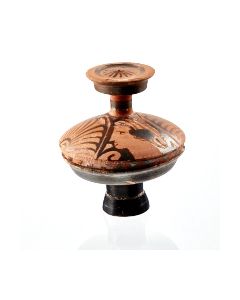 Red figure Apulian lekanis
Red figure Apulian lekanisShallow Greek bowl with high foot, lid with high knob handle. Richly decorated with red figure paintings of female heads and shells. Apulia, 4th century BC
Price: on request Antiker Glasarmreif mit polychromer Verzierung
Antiker Glasarmreif mit polychromer VerzierungRömischer bis byzantinsicher Armreif aus Glas. Nahtlos gefertigt. An der Außenseite polychrome Verzierungen aus Glaspaste.
Price: on request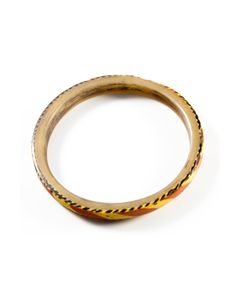 Antiker Glasarmreif mit polychromer Verzierung
Antiker Glasarmreif mit polychromer VerzierungRömischer bis byzantinsicher Armreif aus Glas. Nahtlos gefertigt. An der Außenseite polychrome Verzierungen aus Glaspaste.
Price: on request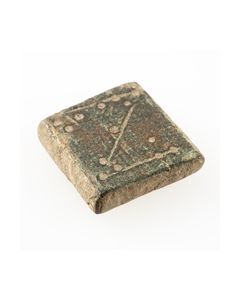 Antikes Gewicht der Einheit 1 Numisma
Antikes Gewicht der Einheit 1 NumismaSpätrömisch bis byzantinisch. Mit eingraviertem N. Bronzegewicht aus dem nördlichen byzantinischen Reich.
Price: on request Antikes Gewicht der Einheit 1 Numisma
Antikes Gewicht der Einheit 1 NumismaSpätrömisch bis byzantinisch. Mit eingraviertem N. Bronzegewicht aus dem nördlichen byzantinischen Reich.
Price: on request Mühlespielbrett aus einer Hypokaustanlage mit Stempel
Mühlespielbrett aus einer Hypokaustanlage mit StempelDas Stück stellt ein Unikat dar. Die Stempellesung ist unbekannt, ebenso wie Vergleichsstücke in der Forschungsliteratur.
Price: on request Polychromer antiker Glasarmreif
Polychromer antiker GlasarmreifRömischer bis byzantinsicher Armreif aus blassgrünem Glas. Nahtlos gefertigt. An der Außenseite polychrome Verzierungen. Hervorragender Zustand.
Price: on request Großer römischer Henkelkrug
Großer römischer HenkelkrugMassiver Krug mit Henkel, Standfuß und Zierrillen. Museale Erhaltung, perfekt zum Aufstellen. 1 Jh. v.Chr. bis 4 Jh. n. Chr., römische Provinz Judäa. Höhe 150mm.
Price: on request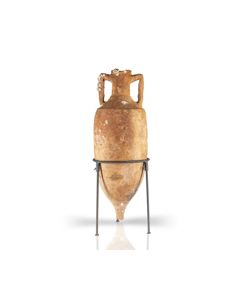 Roman wine amphora with nice sea encrustation
Roman wine amphora with nice sea encrustationVery impressive vessel in an excellent condition. Found 1967 in the sea in Croatia, exported with permit of the local authorities.
Price: on request Extremely rare aureus of Saturninus coined for Probus - 7th known specimen of this coin
Extremely rare aureus of Saturninus coined for Probus - 7th known specimen of this coinDie 7. weltweit bekannte Münze des Saturninus überhaupt und damit eines der seltensten Stücke der römischen Numismatik in exzellenter Erhaltung.
Price: on request Fragment of a Roman brick with maker's mark TA.IN
Fragment of a Roman brick with maker's mark TA.INZiviler Ziegeleibetrieb. Der Fundort ist Trier. Ende 3. bis Beginn 4. Jh. n. Chr. Selten.
Price: on request Large early Etruscan decorated jar
Large early Etruscan decorated jarNicely preserved, from an old German collection, acquired in the late1950s. Found in Latium region (Italy) near Sezze.
Price: on request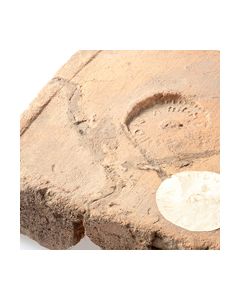 Laterculus bessalis einer Hypokaustanlage
Laterculus bessalis einer HypokaustanlageHypokaustenstein, der als Stützpfeiler für die Fußbodenplatten verwendet wurde. Mit seltenem runden Stempel IIDNIAII...H..
Price: on request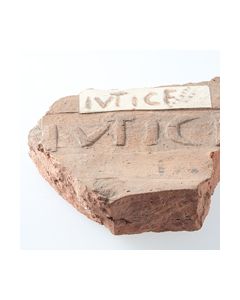 Fragment einer römischen Platte mit Stempel IVTICE...
Fragment einer römischen Platte mit Stempel IVTICE...Der Ziegel gehört zur Gruppe ADIVTE/ADIVTICE, zivile Großziegelei, Ende 3., Beginn 4. Jh. n. Chr.
Price: on request Fragment einer Platte mit Stempel ...APIENA...
Fragment einer Platte mit Stempel ...APIENA...Der Ziegel entstammt der CAPIONACI-Gruppe. Aus einer der vier großen römischen Ziegeleibetriebe im Trierer Raum.
Price: on request Großes Fragment einer Platte mit Stempel CAP...
Großes Fragment einer Platte mit Stempel CAP...Der Ziegel entstammt der CAPIONACI-Gruppe. Aus einer der vier großen römischen Ziegeleibetriebe im Trierer Raum.
Price: on request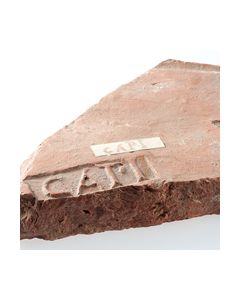 Große Platte mit Stempel CAPI - Musealer Zustand
Große Platte mit Stempel CAPI - Musealer ZustandDer Ziegel gehört der CAPIONACI-Gruppe an. Ziviler Großziegeleibetrieb. Ende 3., Beginn 4. Jh. n. Chr.
Price: on request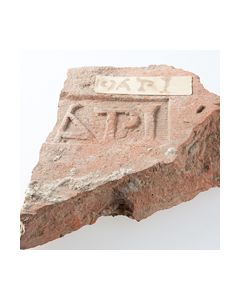 Fragment einer römischen Platte mit Stempel (C)API
Fragment einer römischen Platte mit Stempel (C)APIDer Ziegel entstammt der CAPIONACI-Gruppe. Spätantike, Fundort ist wahrscheinlich Trier.
Price: on request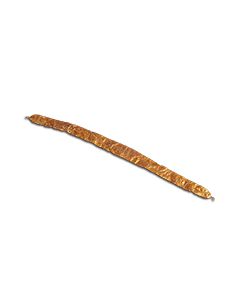 Mycenaean gold diadem
Mycenaean gold diademDelicate piece of ancient jewelry made of gold foil
Price: on request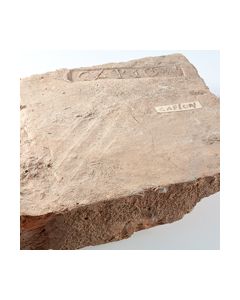 Großer Hypokaustenstein mit Stempel CAPION
Großer Hypokaustenstein mit Stempel CAPIONDer Ziegel gehört der CAPIONACI-Gruppe an. Ziviler Großziegeleibetrieb. Ende 3. bis Beginn 4. Jh. n. Chr.
Price: on request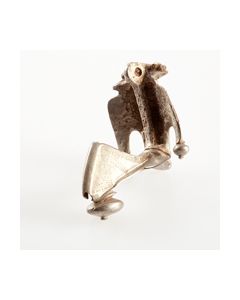 Kräftig profilierte Silberfibel, 2. bis 3. Jh. n. Chr.
Kräftig profilierte Silberfibel, 2. bis 3. Jh. n. Chr.Römische Fibel vom Typ der kräftig profilierten Fibeln. Massives Silber, 34,2g, 100 bis 250 n. Chr. Museumswürdiger Zustand.
Price: on request Four Greek or Scythian arrow heads
Four Greek or Scythian arrow headsGroup of four bronze socketed arrowheads, mainly triangular cross-section. Excellent condition, beautiful patina. From an old German collection, acquired in the early 1980s.
Price: on request Four Greek or Scythian arrow heads
Four Greek or Scythian arrow headsGroup of four bronze socketed arrowheads, mainly triangular cross-section. Excellent condition, beautiful patina. From an old German collection, acquired in the early 1980s.
Price: on request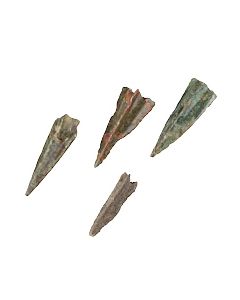 Four Greek or Scythian arrow heads
Four Greek or Scythian arrow headsGroup of four bronze socketed arrowheads, mainly triangular cross-section. Excellent condition, beautiful patina. From an old German collection, acquired in the early 1980s.
Price: on request Four Greek or Scythian arrow heads
Four Greek or Scythian arrow headsGroup of four bronze socketed arrowheads, mainly triangular cross-section. Excellent condition, beautiful patina. From an old German collection, acquired in the early 1980s.
Price: on request Four Greek or Scythian arrow heads
Four Greek or Scythian arrow headsGroup of four bronze socketed arrowheads, mainly triangular cross-section. Excellent condition, beautiful patina. From an old German collection, acquired in the early 1980s.
Price: on request Twelve Greek or Scythian arrow heads
Twelve Greek or Scythian arrow headsGroup of twelve bronze socketed arrowheads, mainly triangular cross-section. Excellent condition, beautiful patina. From an old German collection, acquired in the early 1980s.
Price: on request Four Greek or Scythian arrow heads
Four Greek or Scythian arrow headsGroup of four bronze socketed arrowheads, mainly triangular cross-section. Excellent condition, beautiful patina. From an old German collection, acquired in the early 1980s.
Price: on request Roman ritual mirror showing Leda and the swan
Roman ritual mirror showing Leda and the swanDarstellung der Leda, die mit entblößter Brust am Boden liegt. Von der Seite nähert sich der Schwan. Über der Szene zweireihige griechische Inschrift.
€610 Stamped Roman tile found in Trier
Stamped Roman tile found in TrierThe tile belongs to the ADIVTE/ADIVTICE group and was produced in the late 3rd or early 4th century AD. Found in Trier, Germany.
Price: on request Fragment of a stamped Roman tile
Fragment of a stamped Roman tileThe stamp AYK is not discussed in the literature at hand and thus may be rare.
Price: on request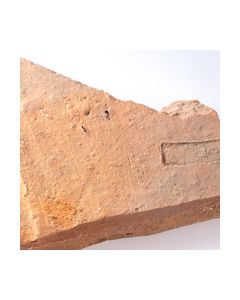 Fragment of a stamped Roman tile
Fragment of a stamped Roman tileProbably manufactured in Treves area, Germany. Roman Empire, 3rd - 4th century A.D.
Price: on request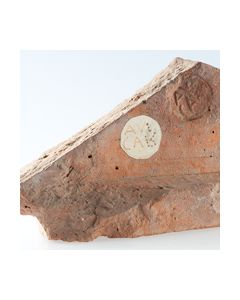 Fragment of a stamped Roman tile
Fragment of a stamped Roman tileThe stamp AV CA is not discussed in the literature at hand and thus may be rare.
Price: on request

